How to Create a Garden-to-Table Meal
Eating fresh, flavorful food is one of life’s simple pleasures. Imagine stepping into your backyard, picking colorful vegetables and fragrant herbs, then preparing a delicious meal with them. This is the charm of a garden-to-table lifestyle: growing your own food and using it to create meals that nourish both body and soul.
In this blog, we’ll explore how you can create your own garden-to-table meal in a simple way. Don’t worry if you’re new to gardening or cooking! Follow these steps and enjoy the process.
Step 1: Grow Your Own Food
The first step to a garden-to-table meal is growing your ingredients. Gardening might sound intimidating, but it can be as simple as planting a few herbs or vegetables in pots or a small plot of land.
Start Small:
If you’re new to gardening, begin with easy-to-grow plants like tomatoes, lettuce, spinach, basil, mint, and parsley. These plants are forgiving and don’t require much space.
Choose Your Location:
Pick a sunny spot where your plants can get at least 6 to 8 hours of sunlight daily. Use well-drained soil and water your plants consistently.
Plan Your Garden:
Think about the meals you want to make. For example, if you love salads, grow lettuce, cucumbers, and cherry tomatoes. If you enjoy Italian dishes, plant basil, oregano, and garlic. Choosing plants based on your favorite meals will inspire you to use them later!
Step 2: Harvest with Care
One of the most rewarding parts of gardening is harvesting your crops. Timing is key to get the freshest flavors.
Know When to Harvest:
For vegetables, pick them when they’re ripe and colorful. For herbs, snip the leaves when they’re young and tender. Don’t wait too long for harvesting; older plants can taste bitter.
Handle with Care:
Use clean scissors or gardening shears to cut vegetables and herbs. Be gentle to avoid damaging the plants so they can keep growing.
Step 3: Plan Your Meal
Creating a garden-to-table meal is all about celebrating the fresh ingredients you’ve grown. Look at what you have harvested and decide on a dish that highlights their flavors.
Keep It Simple:
Fresh food shines on its own, so don’t overcomplicate things. For example, a simple pesto made with basil, garlic, olive oil, and Parmesan cheese can be tossed with pasta for a quick and tasty dish.
Think Seasonal:
Gardens change with the seasons, so use ingredients that are growing now. Summer might give you tomatoes and zucchinis for a roasted veggie platter, while spring could bring greens for a crunchy salad.
Step 4: Cook Using Fresh Ingredients
With your garden treasures ready, it’s time to cook! Thankfully, garden-to-table meals don’t require fancy techniques. It’s all about letting the natural flavors shine.
Rinse Well:
Start by rinsing your vegetables and herbs under cool water to remove dirt or bugs. Pat them dry with a clean towel.
Choose Simple Recipes:
You don’t need complicated recipes to enjoy your homegrown food. For example:
- Salad Idea: Toss fresh lettuce, cherry tomatoes, cucumbers, and a drizzle of olive oil and lemon juice. Add a sprinkle of salt and pepper for a refreshing bite.
- Grilled Veggies: Cut zucchini, bell peppers, and onions into slices. Brush them with olive oil and sprinkle some salt, then grill for a smoky, delicious side dish.
- Herb Butter: Blend softened butter with chopped parsley, garlic, and thyme to make a flavorful spread for bread or roasted veggies.
Don’t Overcook:
Fresh ingredients cook faster and taste better when lightly cooked. Avoid overcooking vegetables and herbs—this helps preserve their vitamins and natural flavors.
Step 5: Enjoy and Appreciate
After cooking, sit down and enjoy your meal. There’s something magical about eating food you’ve grown with your own hands. It connects you to nature and reminds you how much effort goes into the food we eat.
Share Your Meal:
If possible, invite family or friends to join in. Share the joy of eating fresh and healthy food together.
Experiment and Learn:
Every garden-to-table meal is an opportunity to try new recipes, discover your favorite combinations, and learn how to improve your gardening skills.
Why Garden-to-Table Meals Matter
Creating a garden-to-table meal is about more than just growing food—it’s about building a connection to your environment. You eat seasonally, reduce your environmental footprint, and enjoy the satisfaction of preparing food that’s personal and rewarding. Plus, it can even help you save money and improve your health!
Final Thoughts
If you’ve ever wanted to eat fresher, tastier meals, a garden-to-table lifestyle is a great way to start. You don’t need a big garden or professional cooking skills—just the desire to try. A few simple steps can lead to a delicious journey of growing, cooking, and sharing your food.
So, why not start today? Grab some seeds, plant your garden, and celebrate the beauty of homemade meals. Every bite will remind you of nature’s goodness—and your own hard work. Happy gardening and cooking!


